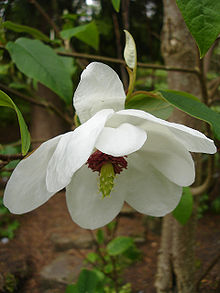- Magnolia wilsonii
-
Magnolia wilsonii
Wilson's Magnolia
Flower Conservation status Scientific classification Kingdom: Plantae (unranked): Angiosperms (unranked): Magnoliids Order: Magnoliales Family: Magnoliaceae Genus: Magnolia Subgenus: Binomial name Magnolia wilsonii
(Finet & Gagnepain) RehderMagnolia wilsonii, the Wilson's Magnolia, is a species of Magnolia native to China, in the provinces of western Guizhou, Sichuan and northern Yunnan, where it grows in the forest understory at altitudes of 1,900-3,000 m, rarely up to 3,300 m.
Description
Magnolia wilsonii is a large spreading shrub or small tree growing to 8–10 metres (26–33 ft) tall. The leaves are elliptic to lanceolate, 6-16 cm long and 3-7 cm broad with a 1-3 cm petiole, and have brown pubescence on the underside. The flowers are drooping, 8-12 cm in diameter, with nine (occasionally 12) tepals, the outer three small and greenish, sepal-like, the main six larger and pure white; the stamens and carpels are crimson. Due to their drooping character, the flowers are best viewed from the underside.
This species is threatened by habitat destruction and collection for medicinal use (see Houpu magnolia), and regeneration is poor.
Cultivation
Magnolia wilsonii, though rare, is in cultivation as an ornamental tree and planted in temperate climate gardens, such as in coastal California. It needs a protected planting location with afternoon shade.
References
- Sun (1998). Magnolia wilsonii. 2006. IUCN Red List of Threatened Species. IUCN 2006. www.iucnredlist.org. Retrieved on 11 May 2006. Listed as Endangered (EN B1+2c v2.3)
- Hunt, D. (ed). (1998). Magnolias and their allies. International Dendrology Society & Magnolia Society. ISBN 0-9517234-8-0
- Flora of China: Magnoliaceae (draft account)
- Photos of flowers and fruit
Categories:- IUCN Red List endangered species
- Magnolia
- Flora of Guizhou
- Trees of China
- Garden plants of Asia
- Ornamental trees
- Endangered plants
Wikimedia Foundation. 2010.

